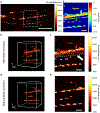Acoustic-feedback wavefront-adapted photoacoustic microscopy
- PMID: 39949550
- PMCID: PMC11824625
- DOI: 10.1364/optica.511359
Acoustic-feedback wavefront-adapted photoacoustic microscopy
Abstract
Optical microscopy is indispensable to biomedical research and clinical investigations. As all molecules absorb light, optical-resolution photoacoustic microscopy (PAM) is an important tool to image molecules at high resolution without labeling. However, due to tissue-induced optical aberration, the imaging quality degrades with increasing imaging depth. To mitigate this effect, we develop an imaging method, called acoustic-feedback wavefront-adapted PAM (AWA-PAM), to dynamically compensate for tissue-induced aberration at depths. In contrast to most existing adaptive optics assisted optical microscopy, AWA-PAM employs acoustic signals rather than optical signals to indirectly determine the optimized wavefront. To demonstrate this technique, we imaged zebrafish embryos and mouse ears in vivo. Experimental results show that compensating for tissue-induced aberration in live tissue effectively improves both signal strength and lateral resolution. With this capability, AWA-PAM reveals fine structures, such as spinal cords and microvessels, that were otherwise unidentifiable using conventional PAM. We anticipate that AWA-PAM will benefit the in vivo imaging community and become an important tool for label-free optical imaging in the quasi-ballistic regime.
Figures




References
-
- Sethuraman S, Amirian JH, Litovsky SH, Smalling RW, and Emelianov SY, "Spectroscopic intravascular photoacoustic imaging to differentiate atherosclerotic plaques," Opt. Express 16, 3362–3367 (2008). - PubMed
Grants and funding
LinkOut - more resources
Full Text Sources
Other Literature Sources
Research Materials
Miscellaneous
